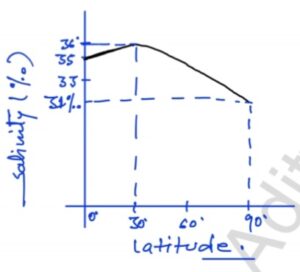Roadmap for Answer Writing 1. Introduction Context: Introduce the concept of El Niño and La Niña as two opposing phases of the natural climate cycle known as the El Niño-Southern Oscillation (ENSO). Mention their importance in global weather patterns. Thesis statement: Explain that ...
Model Answer Impact of Ocean Currents and Waves on Marine Ecosystems Ocean currents and waves significantly influence marine ecosystems in multiple ways, including nutrient distribution, migration patterns, and climate regulation: Larvae Dispersal: Ocean currents act as highways for marine organismsRead more
Model Answer
Impact of Ocean Currents and Waves on Marine Ecosystems
Ocean currents and waves significantly influence marine ecosystems in multiple ways, including nutrient distribution, migration patterns, and climate regulation:
- Larvae Dispersal: Ocean currents act as highways for marine organisms, aiding in the movement and colonization of species. For instance, the North Equatorial Current helps transport coral larvae across vast distances, promoting coral reef diversity.
- Migration Patterns: Currents serve as pathways for marine species such as whales, fish, and sea turtles during their migrations. The East Australian Current, for example, assists in the migration of humpback whales and sea turtles along Australia’s coast.
- Temperature and Climate Regulation: Some currents, like the Gulf Stream, transport warm waters, impacting regional climates. The Gulf Stream affects eastern North America’s climate and supports marine biodiversity in the region.
- Nutrient Transport: Upwelling, driven by ocean currents, brings nutrient-rich waters to the surface, supporting phytoplankton growth, which is the base of the marine food chain. This sustains entire ecosystems.
- Oxygen Distribution: Ocean currents also ensure oxygen distribution in marine environments, moving oxygen-rich surface waters to deeper areas, essential for marine life’s survival.
Impact on Coastal Communities
Ocean currents and waves also have direct implications for coastal communities, influencing climate, economy, and even disaster risks:
- Climate and Weather: Warm ocean currents, such as the North Atlantic Drift, bring milder temperatures to coastal regions, supporting agriculture and tourism. In contrast, cold currents like the Canary Current bring cooler temperatures and fog, affecting local climate.
- Fishing and Economy: Upwelling zones created by ocean currents concentrate nutrients, attracting fish and supporting fishing industries. The Peruvian coast benefits from this high productivity, supporting its economy.
- Navigation and Shipping: Ocean currents assist ships in reducing travel time and fuel consumption, benefiting shipping industries.
- Marine Pollution: Ocean currents can transport pollutants and marine debris to coastal regions, harming ecosystems and human health.
- Disaster Risks: Ocean currents, such as the Gulf Stream, influence storm trajectories and intensity, increasing the vulnerability of coastal communities to hurricanes and storm surges.
In conclusion, ocean currents and waves play a vital role in both marine ecosystems and coastal economies, influencing everything from biodiversity to climate and shipping industries. Understanding these factors is crucial for sustainable coastal management and disaster preparedness.
See less
 However, the Intergovernmental Panel on Climate Change (IPCC) in its recent report highlighted that AMOC is losing its stability and is very likely to decline over the 21st century due to the following reasons:
However, the Intergovernmental Panel on Climate Change (IPCC) in its recent report highlighted that AMOC is losing its stability and is very likely to decline over the 21st century due to the following reasons:

Model Answer Introduction El Niño and La Niña are two opposing phases of the El Niño-Southern Oscillation (ENSO), a natural climate cycle occurring in the Pacific Ocean. These phases influence global weather patterns by altering sea surface temperatures, ocean currents, and atmospheric conditions. ERead more
Model Answer
Introduction
El Niño and La Niña are two opposing phases of the El Niño-Southern Oscillation (ENSO), a natural climate cycle occurring in the Pacific Ocean. These phases influence global weather patterns by altering sea surface temperatures, ocean currents, and atmospheric conditions.
El Niño and La Niña: Key Differences
Global Weather Impact
Both El Niño and La Niña disrupt weather patterns worldwide:
Conclusion
El Niño and La Niña are crucial to understanding global weather patterns, with their far-reaching impacts on regions worldwide. These phases illustrate how interconnected and dynamic the Earth’s climate systems are, requiring proactive risk management and disaster preparedness.
See less